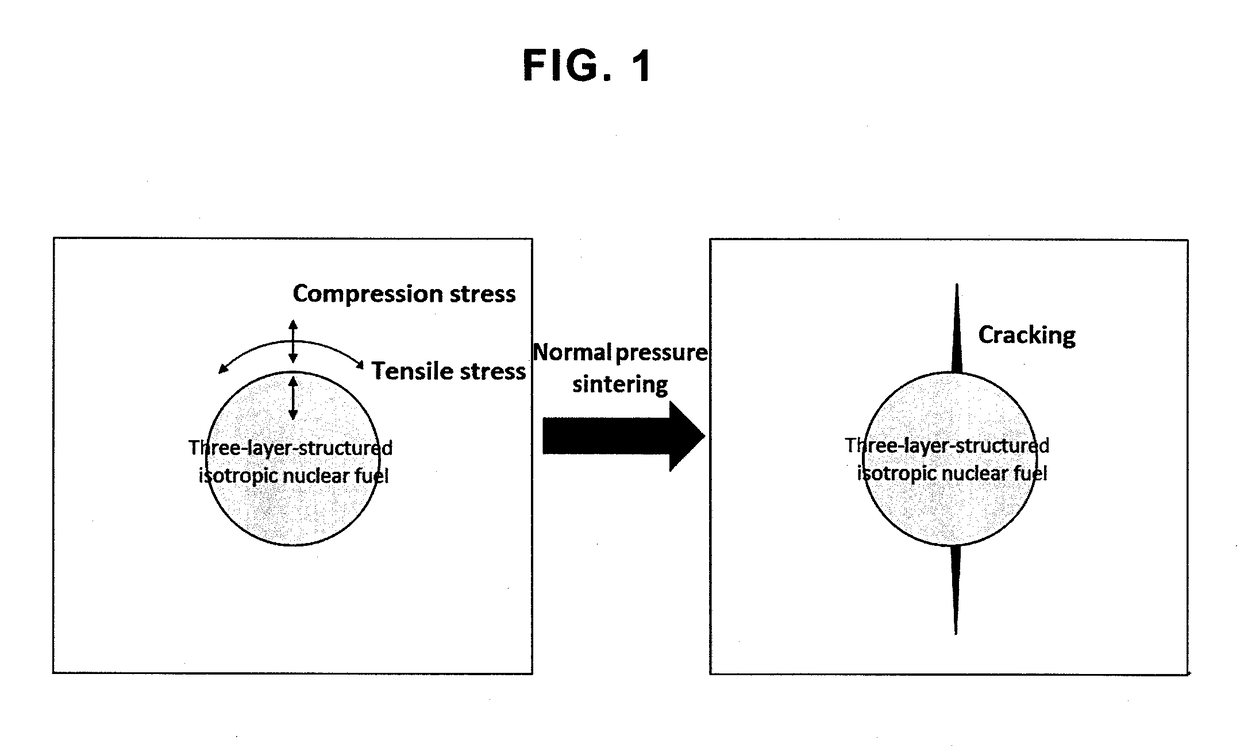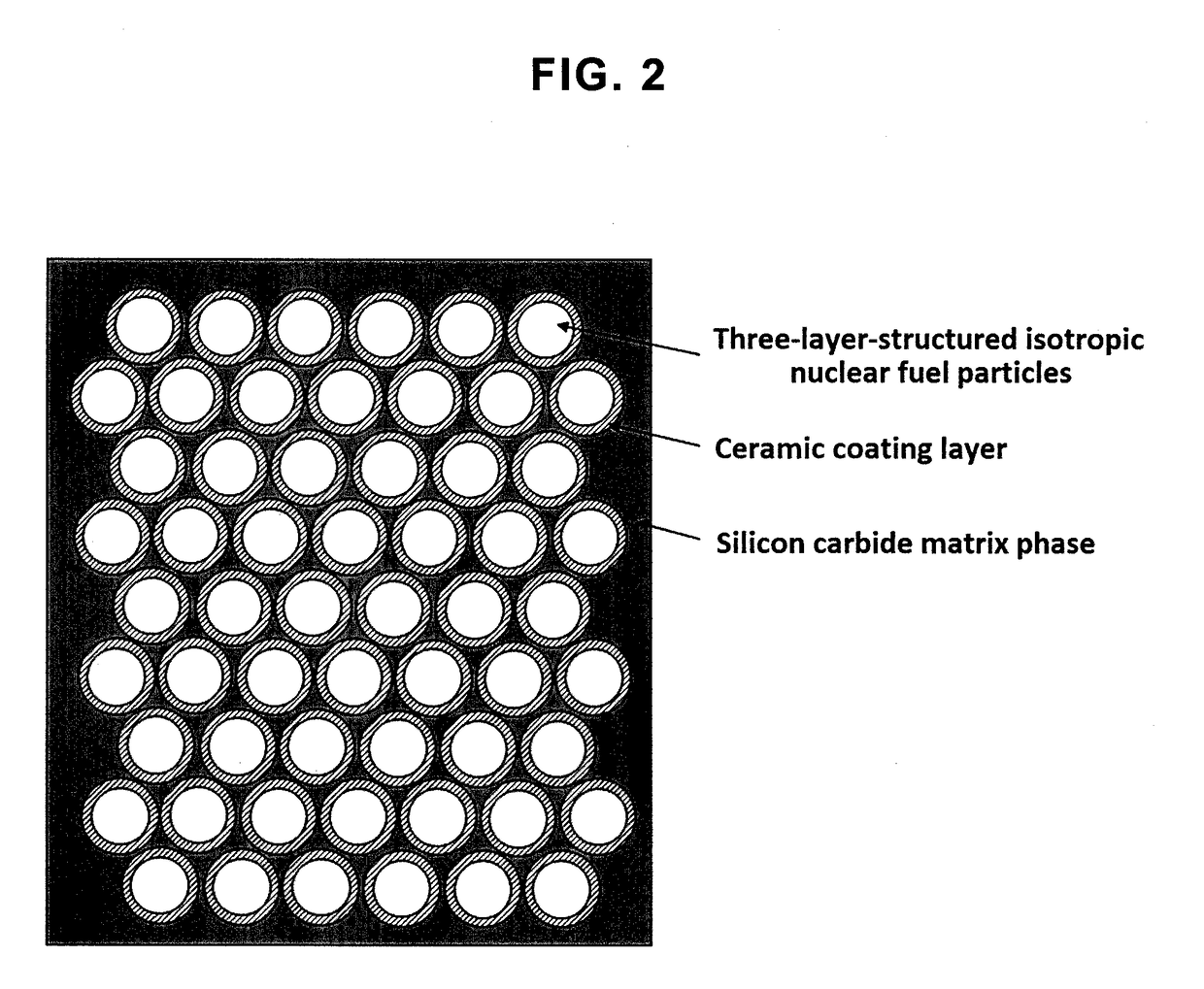Fully ceramic capsulated nuclear fuel composition containing three-layer-structured isotropic nuclear fuel particles with coating layer having higher shrinkage than matrix, material thereof and method for preparing the same
a nuclear fuel and ceramic capsulation technology, applied in nuclear engineering, nuclear fuel, climate sustainability, etc., can solve the problems of increasing instability, damage to the sintered body of nuclear fuel, and critical controversial use of nuclear power, so as to reduce the temperature of the fuel, prevent cracks and pores, and increase the thermal conductivity of the nuclear fuel
- Summary
- Abstract
- Description
- Claims
- Application Information
AI Technical Summary
Benefits of technology
Problems solved by technology
Method used
Image
Examples
exemplary embodiment 1-3
, Exemplary Comparison 1-3
[0087]As described below, in the exemplary embodiment of the present invention, a ceramic capsulated nuclear fuel material including ceramic-coated three-layer-structured isotropic nuclear fuel particles for preventing cracking is prepared by performing steps 1-1 to 1-4.
[0088]1-1. Preparing a Ceramic Coating Layer Slurry Including a Silicon Carbide Precursor
[0089]According to the ratio shown below in Table 1, polycarbosilane is used as the silicon carbide precursor. And, a coating composition for coating three-layer-structured isotropic nuclear fuel particles is prepared by mixing beta-phase silicon carbide powder having an average particle diameter of 0.5 μm within Alumina (Al2O3), Yttria (Y2O3), and Calcia (CaO) each having an average particle diameter of 3 μm. For the composition corresponding to 100 parts by weight, sulphonic acid corresponding to 0.4 parts by weight, polyoxyethylene actylphenol ether corresponding to 0.3 parts by weight, polyethylene g...
embodiment 4
[0106]1-1. Preparing a Ceramic Coating Layer Slurry Including a Silicon Carbide Precursor
[0107]Polysiloxane and xylene resin are used as the silicon carbide precursor, wherein polysiloxane corresponds to 44.8 parts by weight and the xylene resin corresponds to 25.2 parts by weight. Also, 18.0 parts by weight of alpha-phase silicon carbide having an average particle diameter of 0.5 μm is also added, and 8.1 parts by weight of Alumina (Al2O3) having an average particle diameter of 0.5 μm, 2.7 parts by weight of Yttria (Y2O3) having an average particle diameter of 1 μm, and 1.2 parts by weight of Calcia (CaO) having an average particle diameter of 3 μm are added as the sintering additives, and 5 parts by weight of polysiloxane is additionally added as the organic additive, and 73 parts by weight of ethanol is additionally added as the solvent. And, a uniform mixture slurry is obtained by performing ball-milling for 24 hours by using a polyprophylene bottle and a silicon carbide ball.
[0...
PUM
| Property | Measurement | Unit |
|---|---|---|
| particle size | aaaaa | aaaaa |
| porosity | aaaaa | aaaaa |
| temperature | aaaaa | aaaaa |
Abstract
Description
Claims
Application Information
 Login to View More
Login to View More - R&D
- Intellectual Property
- Life Sciences
- Materials
- Tech Scout
- Unparalleled Data Quality
- Higher Quality Content
- 60% Fewer Hallucinations
Browse by: Latest US Patents, China's latest patents, Technical Efficacy Thesaurus, Application Domain, Technology Topic, Popular Technical Reports.
© 2025 PatSnap. All rights reserved.Legal|Privacy policy|Modern Slavery Act Transparency Statement|Sitemap|About US| Contact US: help@patsnap.com



